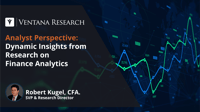
By itself, data isn’t useful for business; the application of analytics is necessary to transform data into actionable information. Data analysis of one sort or another has long been a core competence of finance departments, applied to balance sheets, income statements or cash flow statements. Today, however, Finance must go beyond these basics by expanding the scope of the data being examined to include all financial and operational information that can yield actionable insights. Analysis thus...
Topics: Customer Experience, Human Capital Management, Marketing, Voice of the Customer, business intelligence, embedded analytics, Learning Management, Analytics, Collaboration, Data Governance, Data Lake, Data Preparation, Information Management, Internet of Things, Contact Center, Data, Product Information Management, Sales Performance Management, Workforce Management, Financial Performance Management, Price and Revenue Management, Digital Technology, Digital Marketing, Digital Commerce, ERP and Continuous Accounting, blockchain, natural language processing, robotic finance, Predictive Planning, candidate engagement, Intelligent CX, Conversational Computing, Continuous Payroll, revenue and lease accounting, collaborative computing, mobile computing, Subscription Management, agent management, extended reality, AI & Machine Learning











